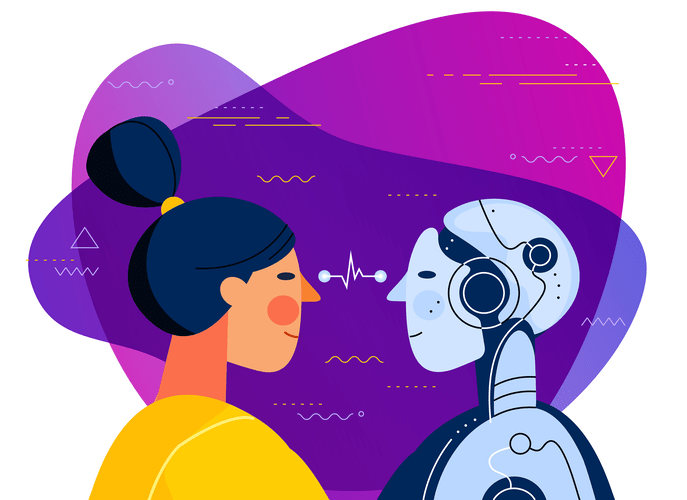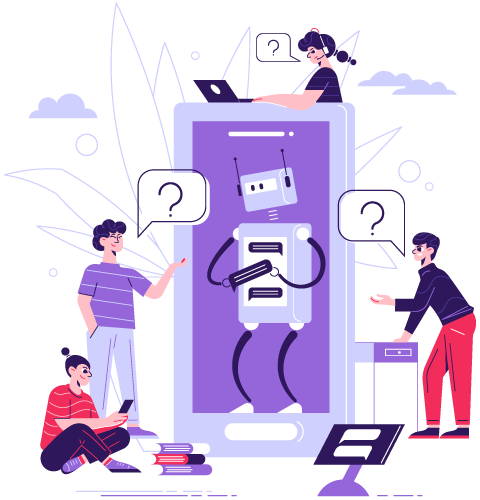Developers have been working relentlessly to solve the issue of bias in artificial intelligence models by developing refined data collection and algorithm designing strategies. The efforts have shown some promising results, but the question still remains… “Will artificial intelligence ever be completely bias-free?”. Details ahead!
“An AI model is only as unbiased as the data it is trained on”. As soon as you start researching about the issue of bias in artificial intelligence, you quickly realize that the root cause of this anomaly is the data and algorithms that the model is being trained under. When a single developer or a group of developers with a similar mindset are assigned the task of developing an AI solution, it is very likely that the solution will come out as biased. This is because we humans have a subconscious tendency to favor one thing over another due to several reasons such as personal experiences, media influence, cognitive processes, and others. And this leads to biases that reflect in the AI services being developed by the developer/developers.
However, with appropriate precautionary steps and a group of demographically rich developers, the effect of bias on artificial intelligence models can be significantly reduced.
Get Complimentary AI Consultation
Why Does an AI Model Become Biased?
There can be several reasons behind an AI model becoming biased, from ‘training the model with an inappropriate data set’ to ‘structuring the development algorithm in an influenced manner’ to ‘unsupervised user interactions ’. Let’s dig deeper into the most common AI bias examples and what causes them:

1. Data Bias
Being the initial step of developing any AI solution, training your AI model with data that’s bias-free to the highest possible extent is crucial. The most common reason why dataset-related bias occurs is due to the inability of the developers to generate training data that is representative of the entire population that the AI technology is supposed to serve. For example, your business designed an AI solution that issues loans to your clients. You provided the details of only your elite members as the training data to set up a credibility benchmark that computes whether the client is eligible for a loan or not. In this case, the AI model being developed will be biased against the other demographic circles of your clients.

2. Algorithmic Bias
In order to minimize bias in artificial intelligence systems it is important to balance the different features within your training algorithm to equally represent the various classes and categories of a data set. The oversampling of one class of the population may create a bias for the other underrepresented groups. For example, your company decides to develop an AI solution that cherry-picks candidates during the initial rounds of an interview process. To this model, you decided to provide the details of your previous year's selected candidates as a training data set. Now it was observed that along with important factors like qualification and experience, the AI algorithm also started to consider factors such as gender and ethnicity to be the deciding factors for selecting a candidate. This will result in a biased data set of the interview selects with significant racial and gender bias instances.

3. Confirmation Bias
Developers often force an artificial intelligence model to look for predefined patterns and confirm already established speculations. This approach itself creates AI bias as it restricts the model from being welcoming towards all possibilities and providing a fair analysis. You can observe instances of confirmation bias across various sectors, especially male-dominated industries like finance and engineering because of the outdated presumptions that these jobs are better performed by male individuals. In case the AI technology is trained by developers with these ideologies it is almost guaranteed that the developed AI system will be biased.

4. Prejudice Bias
Sometimes the datasets being used to train the AI model can show the signs of prejudice and human bias that are present in our modern society. When these dataset-related biases are overlooked, the AI technology designed for them also inherits these biased traits. For example, your company wanted to design a credibility estimation model that analyzes the demographics of your clients. For this, you use the publicly available criminal records to train your AI system about what kind of demographic features represent less credible individuals. This model will very likely be biased towards people of color as the law enforcement officers have had a history of falsely accusing individuals of different ethnicity and thus making an unfair criminal record that is affected by racial bias.

5. Label Bias
Labeling bias is generally observed when an AI model is trained around data points that do not align with the basic rules of AI fairness. If your AI solutions include data points that do not impact the objective of the solution but harm the fairness of the system, the best action would be to completely omit those data points and then continue with the evaluation process. Let’s say your company is willing to design an AI model that analyzes the employee's annual performance to select the best-performing individuals for promotion. In this scenario, the AI technologies do not require any of the demographic data points to provide accurate results and thus they can be removed from the training dataset to ensure artificial intelligence bias mitigation.

6. Feedback Loop Bias
Some machine learning algorithms reinforce the pre-existing bias present in the user’s mind by constantly providing them with more information that reinforces their bias towards a certain topic. For example, a machine learning model designed to recommend articles to your readers based on their preferences. Now, let’s say initially one of your readers developed a liking for articles in favor of a certain political mindset. Ideally, the AI model should recommend the reader articles that have a critical viewpoint towards the party as well.. This will ensure that the reader has an overall understanding of the political organization. But instead, the bias in these machine learning models keeps feeding the reader with more and more articles that are biased in favor of the political group, which creates a cognitive bias for the reader and also harms the fairness of the AI solution.
Build Your Bias-Free AI Model with BinaryFolks
Is There a Way to Reduce the Bias in AI?
Reducing the bias in AI solutions can be primarily discussed in two sections:
Firstly, the pre-production bias alleviation where your company can make sure to follow a set of criteria before designing the solution to make sure that the AI model is less biased
Secondly, the post-production bias alleviation process where the technology is constantly monitored to make sure there is minimum artificial intelligence bias
Let’s look at an overview!

[a] Collect Diverse and Representative Data
The main issue that your company may face during the pre-production phase of an AI development project is that the model has a high probability to be biased as it may not include data that is diverse and representative. Acquiring data from multiple sources and across various demographics can reduce biased data significantly. This is because the main cause of bias in the training data is the lack of perspective that an individual developer or a group of developers of a similar demography may have. By assembling a group of demographically versatile developers the training data can be refined to much more diversity.

[b] Identify and Remove Biases in the Model and Data
Analyzing the data in both pre-production and post-production scenarios is necessary to make sure that both the training data and the synthetic data are bias-free. This is important as a lot of unsupervised pre-production models can be biased due to oversampling of a single data aspect while completely disregarding other data points. In this scenario, the machine learning algorithms may favor the oversampled class, implying inaccurate predictions.
Another scenario is when deep learning models start to become biased based on the synthetic data they generate. If an unsupervised model is interacting with a certain demographic of users more often than the other demographics it is likely that they may start to generate biased results toward that specific group of the population.

[c] Choose Fair and Transparent Algorithms
Having a fair and transparent model not only helps the customers to build trust in your AI projects but also helps your company gain valuable insights and expanded perspectives based on the user's data. Various development algorithms like counterfactual analysis, fairness constraints, and algorithmic auditing can help your business to reduce AI bias during the training process. Alongside these predefined algorithms, the developers can also self-assess their thought processes to maintain the fairness and transparency of the developed model. In a situation where the developer may feel like he does not have a complete grasp of a specific situation and this may lead to bias in data collection, they can consult their clients or fellow developers to get a different viewpoint of dealing with the solution.

[d] Regularly Test and Monitor the AI Model
Post-production AI models generate and store new data every day, and being an automated process it is not monitored regularly. In case your AI technology interacts with the data from biased sources for data extraction and analysis, it is very likely that the model will draw biased conclusions. In this situation, the ideal course of action would be to assess the data regularly to find biased data and remove it from the model entirely. Many companies make the mistake of believing that any data gathered or conclusion deduced by a solution will be 100% accurate, this blind faith harms the businesses’ decision-making capabilities and affects the company’s overall productivity.

[e] Introduce Human Oversight
There is a very common misconception among people who want to implement AI solutions within their businesses. It is that “once our company installs an AI system, we can sit back and relax and let AI do all the work for us!”. This is not the correct approach, as AI models are designed to assist humans with increasing the efficiency of the data collection & analysis of the business and not take over the entire process. But what can be the correct approach to minimize this bias you may ask?
It may sound ironic but, even though human bias is one of the primary reasons behind the bias in machine learning and other AI solutions, the involvement of a human is necessary to monitor and filter the biases from an AI model. This is because the bias does not represent itself in obvious forms, although AI models have become much more refined in the current times there is still a long way to go before they are perfect.
Will the Future AI be 100% Bias Free?
The straight and simple answer would be, no. The AI models heavily rely on humans for the data and algorithms that the solution will be trained under. As we have already discussed that bias within humans is involuntary in most scenarios and it reflects in the data and algorithms that they design, it will become the limiting factor for the bias in the AI models. But that does not devalue AI technology whatsoever.
Bias in artificial intelligence can be dialed down to an acceptable level by making the datasets and algorithms more inclusive and diverse of the multiple data points that a specific solution may have. However, making an algorithm completely bias-free still remains a black box for developers across the globe.
How can BinaryFolks’ Solution Models Reduce Your AI’s Bias?
Now that you know the core concepts of what leads to artificial intelligence bias, let’s quickly come to how BinaryFolks can help you to design a diverse and balanced AI model.

[i] Our Developers Help you Design AI Models Based on Data Sets That Equally Sample Data Points Across Various Classes
Having a dataset that equally samples all the data points can be a good first step that your company can take toward building a bias-free AI model. However, there is no guarantee that having equivalent sets will give you unbiased outcomes, some biases occur due to the inherited bias in the data due to various other factors. We help you to address these issues with a team of developers that always appreciate the stakeholders’ inputs to help reduce the bias of the AI model alongside balanced data sets.

[ii] Create Transparent and Bias-less Training Algorithms with BinaryFolks
Even with a data set that has no artificial intelligence bias, it is not guaranteed that the AI model trained with its help will be bias-free, as a model has the risk of being biased at every stage of development. At BinaryFolks, our developers have hands-on experience with designing well-thought-out AI development algorithms that make sure to maintain transparency with the clients. They also ensure that the unnecessary data point that does not contribute towards the improvement of the AI solution is also promptly removed during the algorithm designing phase itself to affirm that the trained model is reliable.

[iii] Assess your Unsupervised AI Models and Detect Synthetic Bias with BinaryFolks’ AI Services
Even the most accurate AI solutions can be biased over time due to the interaction of individuals that may be biased, this may lead to the AI technology generating synthetic data that is biased. To reduce the risk of this happening to your unsupervised models, BianryFolks provides auditing services that analyze the AI models frequently to point out any possible signs of bias. You as a business owner can then flag the reasons for the occurrence of the bias and optimize the system to reduce the risk of inherited bias.
Conclusion
The general overview for bias in artificial intelligence states that in most cases the bias is created unintentionally either because of the lack of diversity in the development team or due to the use of datasets that favor data points of a certain class more than the other classes creating an imbalance.
(1) Primary Detectable Bias Factors
We observed that the bias in the AI models exists mainly due to the limited perspective of an individual developer which leads to various aspects of detectable biases.
- Data Bias
- Algorithmic Bias
- Confirmation Bias
- Prejudice Bias
- Label Bias
- Feedback Loop Bias
(2) Measures to Alleviate Artificial Intelligence Bias
Having an ambiguous and transparent approach can reduce the bias of an AI model in the early stages like data collection and algorithm designing. This will reduce the risk of the AI technology inheriting biased traits during the training period.
- Collect Diverse and Representative Data
- Identify and Remove Biases in the Model and Data
- Choose Fair and Transparent Algorithms
- Regularly Test and Monitor the AI Model
- Introduce Human Oversight




.png)
.png)